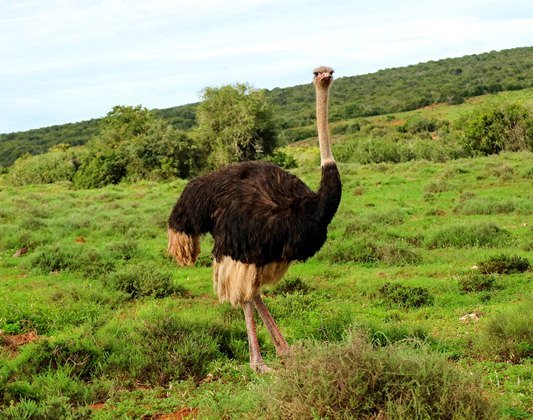Stories of a proud tradition

Author: Ivan Lätti
Photographer: Martin Etsebeth
There were much bigger bird-like creatures in dinosaur time, like Gigantoraptor erlianensis, about 3,5 m tall. And later there came and went several species (and even genera) of elephant birds, in Australia, Madagascar and elsewhere on earth; their bones lasting in fossil form, sustaining the odd university department.
Not all these ancient bird-like creatures bore feathers and, in many cases, had no chance of flight. The big brute birds and other beasties taught our ancient forefathers how pathetically slow the (almost) human running speed was. Hairy, low-browed “people” inconveniently had to use their brains or what they had of it, not only their legs to stay ahead of doom.
Such lessons were only properly learnt by the brainier ones that got away to breed, bringing about more evolution. Another lesson mastered, but only later in ostrich time, involved the use of a long branch, particularly a thorny one where available, held higher than the head of the ostrich to intimidate it. And when that does not work well enough, the thorns threatening the eyes usually do.
There are fossil records of ostrich presence in India to Mesopotamia and Syria; the birds having been around widely in the old, fence-free world. Species history, buried in the past for people either to study, invent to taste or merely imagine in deluded meanders of the mind, is for most living things a complex account of becoming.
The truth or actual reality is boring in comparison to the accumulation of man-made myths concerning most species, including the ostrich. Trust people to conjure cathedrals full of stories, unfounded machinations and theories about everything that takes their fancy, while the truth could fit into a hut.
Don’t be too hard on people and their stories: We are dependent on storytelling and story hearing, a condition caused by our main feature being an ample but under-used brain that thrives on memes floating in and out at comfortable rate. A new story every night for a thousand nights and then random repeats of all the old ones into old age, with the occasional twist or surprise! That is how people like to live.
For instance, some reckon the big bird bone remains in rock (as well as all the other funny fossils), are not that old at all: All merely prefab decorations put there miraculously at creation time without such bones ever having had flesh upon them at all. These decorative rock embellishments are thus only meant to test human faith in the miraculous event itself, said to have happened some 5000 year ago.
The choice of ones preferred story about anything is governed by education, age, class and individual mental functioning. This results in habits of belief and choice.
Human stories range from freaky fancy to a semblance of science, all made up to “understand” or feel comfortable with the world, but mainly to keep the youth from belief mischief. Sadly, there will always be those deviant few in society in whom stale stories cause curiosity, steering them straight into rebellion or worse… independent thought and rigorous investigation. How utterly infra dig!
Well, today we still have the ostrich, its evolutionary antecedents long lost, locked in rock or loping far afield in fluffy dreams, deceiving dogma or scientific endeavour.
This bird, its kind inextricably enmeshed in the life and lore of the Little Karoo, was photographed in the Addo Elephant National Park where ostriches roam with elephants, enduring people travelling in cars and collecting photos for illustrating their stories.
So, look this guy in the eye and convince yourself there is not a story embryo wriggling deep down in your mind that will put the children to sleep, or give them nightmares for a week!

